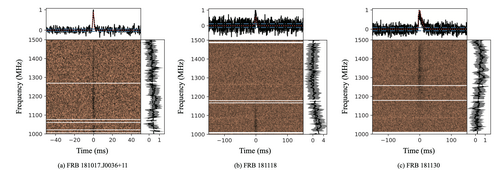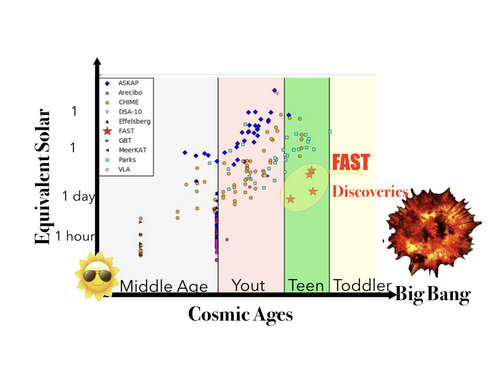FAST Captures Distant Fast Radio Bursts from the Youth of Universe
Fast Radio Burst (FRB) is a kind of mysterious radio flashes lasting only a few thousandths of a second. Confirmed to be the cosmological origin in 2016, FRB has the potential to provide insights into a wide range of astrophysical problems.
Dr. NIU Chenhui from the team led by Dr. LI Di and Dr. ZHU Weiwei from National Astronomical Observatories of Chinese Academy of Sciences discovered three new FRBs with high dispersion measure from the massive data of the Five-hundred-meter Aperture Spherical radio Telescope (FAST).
Their findings were published in The Astrophysical Journal Letters.
The discovery indicated that these three FRBs happened billions of years ago when the Universe was still in its youth.
The newly discovered FRBs, along with the first FRB detected by FAST last year, suggest that there could be as many as 120,000 detectable FRBs arriving on Earth every day.
"We are catching up in terms of data processing and expecting more discoveries from FAST, the most sensitive radio telescope in the world," said Dr. NIU Chenhui, the first author of the paper.

Fig. 1: Three new FRBs (Image by NIU Chenhui et al.)
Comparing FRB samples from the Parkes telescope and the Australian Square Kilometre Array Pathfinder (ASKAP) telescope, researchers from Australia revealed the relation between the fluence (integrated flux) and the dispersion measure of FRBs. The new discovery helps extend such relation and cover some previously less explored parameter space.
"Combined with simulations, FAST could detect FRBs with redshift larger than 3, i.e., more than 10 billion years old," said Dr. NIU.
The distribution of the dispersion measures of these FRBs was sensitive to the shape of the intrinsic brightness distribution of these cosmic events. "More discoveries from FAST will thus help reveal the yet unknown origin of FRBs," said Dr. LI Di, the corresponding author of the study and the chief scientist of FAST.

Fig. 2: The FRB samples from FAST all locate in a previously empty region (red ellipse) in the brightness (vertical) - cosmic ages (horizontal) space. (Image by NIU Chenhui et al.)
This paper can be accessed at https://iopscience.iop.org/article/10.3847/2041-8213/abe7f0
Media Contact: Prof. XU Ang, annxu@nao.cas.cn